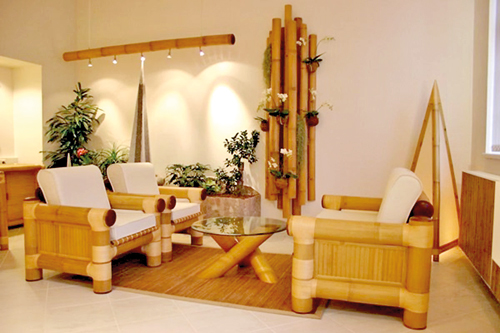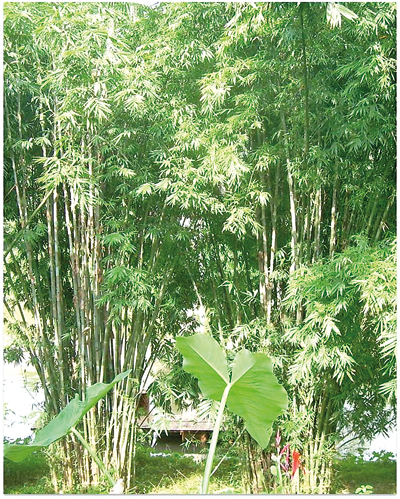Bamboo for environmental and economic benefits: Constraints in Sri Lanka

Bamboo furniture
Woody bamboo is accepted as a super new material that can replace timber. It is a valuable resource that can generate new industrial products of high economic returns, leading to protecting forests and the environment, benefiting mankind immensely. Although the global rise in the use of bamboo has been relatively recent, bamboo culture has been an essential part of human history and civilisation in Asia and South America in the past. It is necessary to protect natural bamboo resources and promote its cultivation to ensure sustainable utilisation.
China has the largest and fastest growing bamboo sector involving 10 million bamboo farmers, generating 35 million jobs and a value of US$10.5 billion. Vietnam, Indonesia, Thailand and Philippines also have a significant bamboo resources and export markets with India following.
Although attempts have been made in
Sri Lanka to promote cultivation of bamboo for various end uses, it has not yet made significant progress. There is also some degree of misconception and skepticism curtailing this drive. Constructive criticism and education should be able to address these issues and encourage its cultivation for the immense environmental and economic benefits bamboo can offer.
Misconceptions
There is a misconception that all bamboos in general are invasive. This is not so as the woody bamboos especially the tropical ones found in the island are of the sympodial types that form a clump unlike the monopodial or runner-type common in temperate countries where the underground rhizome spread in all directions. This skepticism has arisen due to the extensive spread of an endemic thorny bamboo, Bambusa bambos (katu una) or B Bamboos in some parts of the dry zone. In India it is widely used in the paper pulp industry and manufacture of timber substitutes and is not an invasive plant. B bambos is also common in many countries of this region and is utilised in spite of the presence of thorns. Its fast growing nature could be used to advantage by planting as a fence to prevent elephants crossing into villages and poles could be utilised for controlling excessive spread. Another thorny bamboo, Dendrocalamus strictus was introduced from India by the Forest Department for the paper pulp industry. It was planted in the North but its fate is not known. Both these species thrive in dry and arid climates and have high biomass. The truly endemic bamboos of Sri Lanka are the reed bamboos (bata) common in the hill country such as species of Arundinaria, Davidsea attenuate etc and Ochlandra stridula in Kalutara and Avissawella. These were at one time used in making handicrafts but the craft is now on the decline for various reasons. Bamboo baskets used by the tea pluckers were made of these but are now replaced with lighter ones made of synthetic material. In the up country too there are patches of reed bamboo not in use. In fact, many of these endemic bamboos are under threat of extinction needing conservation before they are lost forever. The woody bamboos common in many parts of the island are not considered as invasive but have been in cultivation for many decades for soil stabilisation on stream and river banks, steep slopes and in rehabilitating degraded soil. The FAO and International Network of Bamboo and Rattan (INBAR) reported (in 2018) that a severely degraded soil after an intensive brick making industry in Allahabad, India was restored and re-vegetated following bamboo planting. After 20 years the ground water table rose by 10 metres and agricultural crops and trees were incorporated into a bamboo landscape. The villagers also found a new livelihood by utilising and selling bamboo poles. In Chishui, China surface runoff was reduced by 25 per cent compared to an adjacent sweet potato farm. Similar cases studies of land restoration are reported from other countries. These should dispel misconceptions in this country that bamboo takes up much water from soil and leads to desertification. Any fast growing plant needs water. Crop plants such as rice, coconut, banana, etc also absorb much water from soil and a comparison of water use shows that these are no different. Bamboo is environment friendly and is able to store a large amount of water in the rhizome and culms as well as in the soil. It conserves water by shedding leaves during dry periods. This is why we do not see bamboo clumps dying during adverse dry spells.
Facts

Bamboo trees
It is sad that these facts are not known by the policy makers. Illegal sand mining has resulted in dislodging bamboo planted along some parts of river banks. Unlike trees, bamboo does not have a very deep root system and the rhizome bearing roots form an underground network that penetrate only a few feet in depth and spread over a wide area; and this the reason why it is difficult to uproot bamboo. With sand miners digging below the rhizome, smaller species of bamboo and newly planted saplings are easily dislodged. It is necessary to stop these illegal activities rather than start canvassing to stop bamboo planting along riverbanks as is happening now! The Central Environmental Authority should take rightful action on this regard. I have never seen an entire giant bamboo clump uprooted in this manner as it has a deep underground system. Another fact that needs attention is that bamboo culms age and senesce and eventually break away from the main clump and drift into the river especially during heavy rain and floods prevalent now. Older culms of bamboo wherever it is grown need to be cut and removed. This helps in clump rejuvenation and new culm growth. Although the Mahaweli Authority initiated cultivation of bamboo along river banks to protect the river, their maintenance and utilisation were overlooked. When the late Prof. Aries Kovoor initiated this Riverine Bamboo Project then under the President of Sri Lanka in 1997, it was with the view of protecting the river bank on either side to form live wall and later use of the resource in a paper pulp industry. A report of the “Guidelines for the Preparation of a Five Year Forest Management Plan” by the Ministry of Plantations, also recommends that management of bamboo after its cultivation along river or stream banks is essential. Thus bamboo culms need to be sustainably harvested and made use of.
Tea plantations
Abandoned tea plantations with impoverished soils are ideal for bamboo planting. These should be previously terraced and the bamboo planted along terraces can be used as a fuel wood in the tea industry or as fuel for dendro power. In a scientific report on the suitability of bamboo as an energy resource in China, culms aged two to three years of Moso bamboo and those of five years of B. emeiensis are reported to have a calorific value ranging from 18.5 to 19.5 MJ per kg. The authors conclude that these are suitable to be used as a fuel for biomass-fed combustion plants. Similar studies in high biomass species available in the country will help in identifying culm age and the most suitable species for fuel wood. Present practice of the use of wood from trees is not sustainable for obvious reasons.
Bamboo is able to absorb heavy metals and pollutants faster than any other tree due to its fast growth. This potential has been exploited to clean a heavily polluted lake in Africa. The World Agro Forestry Sector (ICRAF) and the Jomo Kenyata Agricultural University together with a private entrepreneur planted Giant bamboo (Dendrocalamus giganteus) in the Vinam gulf, an entry point to Lake Victoria in Kenya polluted with sewage and garbage. We could use this potential of bamboo to remove pollutants and heavy metals from the garbage dumps in Sri Lanka. The Tissue Culture Facility of the Mahaweli Authority should be able to supply bamboo plants. This will have numerous benefits especially to the folks living in areas with polluted soil. Bamboo will grow faster than trees and soon form a screen to prevent outflow of dust, cover the unsightly scene, remove pollutants in the soil, bind top soil to control erosion, absorb carbon dioxide and fix carbon. A hectare of giant Moso bamboo (Phyllostachys pubescens) in China is reported to fix 250 tonnes of carbon per hectare per year and will continue to fix as long as bamboo grows over the years. There are species of giant bamboo naturalised here which could be planted in these areas. In about five to six years, bamboo poles would be ready for harvesting. Numerous possibilities will arise for livelihood development by the establishment of treatment facilities for culm preservation, bamboo splitting machines etc in these villages.
Other issues
There are also other issues which need to be addressed. Harvesting of bamboo from state land and transport of bamboo even from private lands, needs permits. This is cumbersome although it may appear to be easy on paper. To overcome this and encourage a bamboo industry, India ruled that bamboo grown in private lands be considered a grass as cutting and transport of grass does not need permits while those in forests will remain categorised under trees to control over exploitation. China was able to expand its bamboo cultivation rapidly in the mid- 1980s with a series of policy reforms that impacted land tenure, forest use rights, markets for the farmers and commercialisation. Almost 82 per cent of land in the island is state-owned including unused and land not suitable for agriculture. Farmers will hesitate to grow bamboo in these as they will not be sure of ownership of the bamboo unless policies such as those implemented in China are established.
Another important issue at hand is that many countries now do not accept bamboo or its products unless they are certified as green. Under the new standards of the Leadership in Energy and Environmental Design (LEED) of the US Green Building Council (USGBC), bamboo products originating from farmed plantations must comply with Sustainable Agriculture Standards of the Sustainable Agriculture Network or if otherwise obtained must have been legally harvested to get green credits. Bamboo craft workers are now unable to export their products without this green certificate. As a first step, it is necessary to identify areas with mature bamboo (including those planted by the Mahaweli Authority) and ensure sustainable harvesting to get the green certificate.
Clear policy directives and commitment by the Government and a scientific approach should enable addressing all issues regarding misconceptions of bamboo and its cultivation for the immense environmental and economic benefits for the country.
(The writer is a Scientist/Consultant in bamboo and plant tissue culture. He can be reached at shantharamanayake@yahoo.com).


